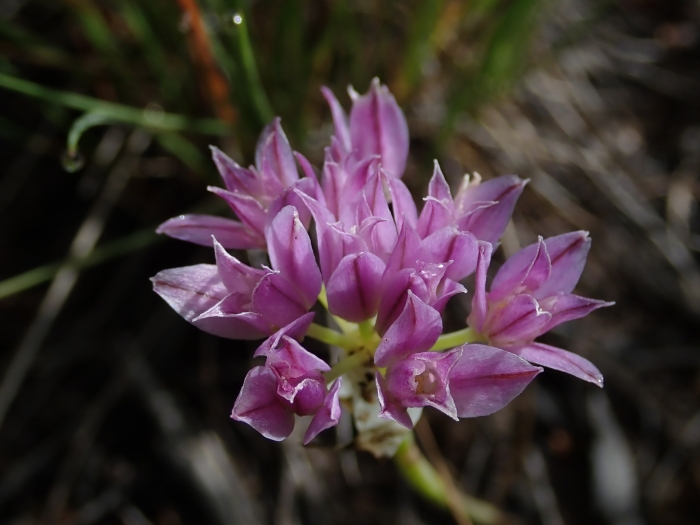Tapertip Onion
(Allium acuminatum)
Tapertip Onion (Allium acuminatum)
/
/

Nolan Exe
CC BY 4.0
Image By:
Nolan Exe
Recorded By:
Copyright:
CC BY 4.0
Copyright Notice:
Photo by: Nolan Exe | License Type: CC BY 4.0 | License URL: http://creativecommons.org/licenses/by/4.0/ | Rights Holder: Nolan Exe | Publisher: iNaturalist | Date Created: 2022-06-09T21:31:40-07:00 |

























Estimated Native Range
Summary
Allium acuminatum, commonly known as the tapertip onion or Hooker’s onion, is a perennial herb native to dry meadows, open woodlands, and grassy slopes in the Western United States and Canada, including British Columbia. It thrives in these sunny, well-drained habitats, often among brush and pines. The plant typically grows to a height of 8 to 16 inches (20 to 40 centimeters) and is characterized by its narrow, conical bulbs that are less than 1 inch across. From late spring to early summer, it produces a scape up to 16 inches tall bearing an umbel of 20 to 40 vibrant pink to purple flowers with contrasting yellow anthers, which are quite showy and attract pollinators. The plant also has two or three grooved leaves that wither before the flowers bloom.
The tapertip onion is valued for its ornamental flowers and is used in rock gardens, native plant gardens, and as a border plant. It is drought-tolerant and requires minimal maintenance once established, making it a suitable choice for xeriscaping. In cultivation, it prefers full sun and well-drained soils, mimicking its native dry meadow conditions. While it is not commonly afflicted by diseases, overwatering can cause bulb rot. The bulbs and flowering stalks are edible, with the stalks having a milder flavor, and have been traditionally harvested by indigenous peoples for culinary use.CC BY-SA 4.0
The tapertip onion is valued for its ornamental flowers and is used in rock gardens, native plant gardens, and as a border plant. It is drought-tolerant and requires minimal maintenance once established, making it a suitable choice for xeriscaping. In cultivation, it prefers full sun and well-drained soils, mimicking its native dry meadow conditions. While it is not commonly afflicted by diseases, overwatering can cause bulb rot. The bulbs and flowering stalks are edible, with the stalks having a milder flavor, and have been traditionally harvested by indigenous peoples for culinary use.CC BY-SA 4.0
Plant Description
- Plant Type: Herb, Bulb
- Height: 0.3-1 feet
- Width: 0.1-0.3 feet
- Growth Rate: Rapid
- Flower Color: Pink, Purple, White
- Flowering Season: Spring, Summer
- Leaf Retention: Deciduous
Growth Requirements
- Sun: Full Sun, Part Shade
- Water: Low, Medium
- Drainage: Fast, Medium
Common Uses
Bee Garden, Butterfly Garden, Deer Resistant, Low Maintenance, Rock Garden
Natural Habitat
Native to dry meadows, open woodlands, and grassy slopes
Other Names
Common Names: Taper-tip Onion
Scientific Names: , Allium acuminatum, Allium acuminatum var. cuspidatum, Allium cuspidatum, Allium elwesii, Allium murrayanum, Allium wallerianum, Allium wallichianum,
GBIF Accepted Name: